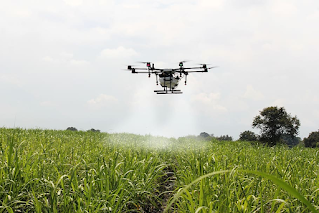What is Flysky FS-i6 6CH 2.4GHz Radio System RC Transmitter - All you need to know
1. Introduction
The world of remote-controlled vehicles and drones has seen significant advancements in recent years. Among the essential components of any RC system is the transmitter, which allows you to control your vehicle or aircraft. One popular choice among enthusiasts is the Flysky FS-i6. In this comprehensive guide, we will delve into the Flysky FS-i6, exploring its features, setup procedures, and more. Whether you're a beginner or an experienced RC enthusiast, this guide will help you get the most out of your Flysky FS-i6 transmitter.
2. Understanding the Flysky FS-i6
The Flysky FS-i6 is renowned for its exceptional features, making it a top choice in the RC community. Some of its key features include:
6-Channel Control: The FS-i6 provides six channels, giving you precise control over various functions of your RC vehicle or aircraft.
2.4GHz Frequency: With a 2.4GHz frequency band, this transmitter offers excellent signal stability and reduced interference.
LCD Screen: The built-in LCD screen provides real-time telemetry data, allowing you to monitor your vehicle's performance.
Model Memory: The FS-i6 can store up to 20 different models, making it suitable for a wide range of RC applications.
Easy Navigation: The intuitive user interface and easy-to-use menu system make navigation a breeze.
2.2 Specifications
Before diving into the setup process, let's take a look at the specifications of the Flysky FS-i6:
- Channels: 6
- Frequency: 2.4GHz
- Model Memory: 20
- LCD Screen: Yes
- Transmitter Battery: 4 AA Batteries (Not Included)
- Range: Approximately 300 meters
3. Setting up Your Flysky FS-i6
Now that we have a basic understanding of the Flysky FS-i6, let's go through the setup process step by step.
3.1 Binding
Binding your FS-i6 transmitter to your RC receiver is the first step in the setup process. Follow these steps:
Turn off both the transmitter and the receiver.
Insert batteries into the transmitter and power it on.
Connect the binding plug to the receiver.
While holding down the binding button on the transmitter, power on the receiver.
The transmitter and receiver should now bind, indicated by a solid light on the receiver.
3.2 Calibration
Calibrating your FS-i6 transmitter is crucial for accurate control. Follow these steps:
Access the calibration menu on your FS-i6.
Ensure that all control sticks and switches are in their default positions.
Follow the on-screen prompts to calibrate each channel.
Save your calibration settings.
3.3 Firmware Update
It's essential to keep your FS-i6 transmitter's firmware up to date for optimal performance. Visit the Flysky website and download the latest firmware update. Follow the provided instructions to update your transmitter's firmware.
4. Programming Your Transmitter
4.1 Creating Models
The FS-i6 allows you to create and save multiple models for different RC vehicles. Here's how:
Access the model menu on your transmitter.
Select "Create New Model."
Follow the on-screen prompts to configure your model settings, including name and type.
Save your new model.
4.2 Channel Assignments
Configuring channel assignments is crucial for customizing your RC vehicle's controls. Follow these steps:
Access the channel assignment menu.
Assign specific functions to each channel according to your vehicle's requirements.
Save your channel assignments.
4.3 Mixing
Mixing allows you to combine channels for more advanced control. Follow these steps:
Access the mixing menu.
Configure mixing settings based on your vehicle's needs.
Save your mixing settings.
4.4 Dual Rates and Exponential
Dual rates and exponential settings affect the sensitivity and responsiveness of your controls. Adjust these settings according to your preferences and skill level.
4.5 Fail-Safe Settings
Setting up fail-safe ensures that your RC vehicle returns to a predefined state in case of signal loss. Configure fail-safe settings for safety.
5. Flysky FS-i6 FAQs
Q1. What batteries should I use for the FS-i6 transmitter?
A1. You should use four AA batteries for the FS-i6 transmitter. Rechargeable NiMH batteries are a cost-effective and eco-friendly option.
Q2. How can I update the firmware on my Flysky FS-i6?
A2. To update the firmware, visit the Flysky website, download the latest firmware update, and follow the provided instructions for installation.
Q3. Can I use the FS-i6 with different RC models?
A3. Yes, you can. The FS-i6 allows you to create and save multiple models, making it versatile for various RC applications.
Q4. What is the range of the Flysky FS-i6 transmitter?
A4. The FS-i6 has a range of approximately 300 meters, providing reliable control over a significant distance.
Conclusion
In conclusion, the Flysky FS-i6 is a feature-rich and versatile transmitter that caters to the needs of both beginners and experienced RC enthusiasts. With its user-friendly interface, extensive model memory, and customization options, it's a valuable addition to your RC gear.
By following the setup and programming guidelines outlined in this guide, you can make the most of your Flysky FS-i6 transmitter, ensuring precise control and an enhanced RC experience. Whether you're piloting a drone, driving an RC car, or sailing an RC boat, the FS-i6 is a reliable companion for your adventures in the world of remote-controlled vehicles.

.png)


.png)
